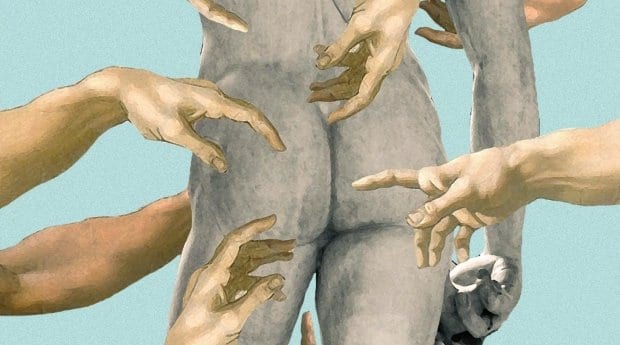Since it was unveiled in 1504, the world has been aquiver over Michelangelo’s David, a specimen of perfect, marble, adolescent boy flesh. Young David of biblical legend, nude, lean, standing contrapposto, muscles pulled taut, his brow furrowed in apprehension, anticipating single combat with the giant Philistine Goliath. This pinnacle of art hints at Michelangelo’s relationships with men: the subject remains at a tortured, artistic distance. Basically, divine creative wanking over hot young man flesh.
Michelangelo di Lodovico Buonarroti Simoni was born in 1475 in an Eastern Tuscan village; his family returned to their home in Florence before he was a year old. After his mother’s death when he was six, Michelangelo was sent to live with a stonecutter in a town where his father owned a quarry and farm.
At 13, Michelangelo was positioned as the paid apprentice of a master fresco painter, and he was soon hand-picked to study at Florence’s Humanist Academy, under the patronage of Lorenzo de’ Medici.
Michelangelo’s fame as a sculptor came not only within his lifetime, but at a relatively young age. At the Humanist Academy he completed a sumptuous Madonna of the Steps relief and an orgiastic Battle of the Centaurs sculpture. By the time he was 29, he had finished David and was soon conscripted to Rome by Pope Julius II, where he started churning out products for the Vatican; that work would occupy much of the rest of his life.
While he is renowned as a sculptor, painter and architect, little attention is paid to his poetry; he was, after all, a Renaissance man. Later in life, around 1532, he met a young Roman nobleman named Tommaso dei Cavalieri. One biographer notes this was a period when Michelangelo was at “the richest in poetical compositions.”
He doted on the youth, giving him poems and artwork. Cavalieri, who would have been about 23 when he met Michelangelo, was described by one contemporary poet as having “not only incomparable physical beauty, but so much elegance of manners, such excellent intelligence and such graceful behaviour that he well deserved, and still deserves, to win the more love the better he is known.” The poet recounts a poem Michelangelo wrote for Cavalieri that begins:
Why should I seek
to ease intense desire
With still more tears
and windy words of grief,
When heaven, or late
or soon, sends no relief
To souls whom love hath robed around with fire?
This burning, tortured desire for other men was routine for Michelangelo. During a relationship with Gherardo Perini, one of his models, Michelangelo was often stood up. The spurned artist would pass a lonely, anxious night, then write notes like this to himself: “Whereas other men take their pleasure, I do but mourn, prostrate on the ground, lamenting and weeping.”
His passionate friendship with Cavalieri was at least emotionally reciprocated. Cavalieri cared for and respected Michelangelo deeply. The two remained lifelong friends, and Cavalieri was present at the artist’s death. Even more fascinating is the idea that Michelangelo’s collected poems to Cavalieri predated Shakespeare’s “Fair Youth” sonnets by half a decade.
The relationship seems to have caused some discomfort for Michelangelo’s family. His nephew, also named Michelangelo, writing about the aforementioned piece, stressed “that this sonnet, as well as the preceding number and some others, are concerned, as is manifest, with a masculine love of the Platonic species.” Michelangelo’s letters to Cavalieri, however, suggest feelings of a different nature:
“I know well that, at this hour, I could as easily forget your name as the food by which I live; nay, it were easier to forget the food, which only nourishes my body miserably, than your name, which nourishes both body and soul, filling the one and the other with such sweetness that neither weariness nor fear of death is felt by me while memory preserves you to my mind.”
These sentiments, as divine and affecting as his sculptures, make even jaded old me blush.
Check out our interview with the organizers of Michelangelo: Quest for Genius at the AGO, wherein we attempt to answer the question was Michelangelo gay?


 Why you can trust Xtra
Why you can trust Xtra


